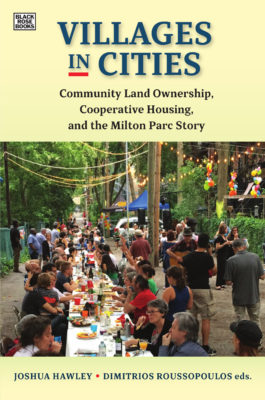In 1968, residents of a six-block area east of McGill University mobilized to protect their working-class neighbourhood from the grips of Concordia Estates, a real estate developer intent on demolishing it in order to spawn a high-rise, high-rent building complex. It launched a decade-long battle that led to the creation of Canada’s biggest non-profit cooperative housing project, Communauté Milton-Parc, in 1983.
Initially a fight for the preservation of low-income housing for residents and of Victorian greystone buildings, the Milton Parc community’s struggle quickly escalated into a cooperative vision and movement buoyed by then- radical ideas of community organizing and participatory democracy. Alongside demonstrations, lobbying, pamphlets, and sit-ins, community institutions were born, such as a day care, a newspaper, a health clinic, a food coop, a legal clinic, and a credit union.
Villages in Cities: Community Land Ownership, Cooperative Housing, and the Milton Parc Story tracks the community resistance and solidarity that scuppered Concordia Estates, alongside looking at the efforts and achievements of cooperative housing movements worldwide. It’s an academic guide for communities that want to protect their neighbourhoods from the claws of real estate speculation and gentrification, a toxic pollutant that discharges urban renewal at the cost of displacing original inhabitants, according to editors Joshua Hawley and Dimitrios Roussopoulos.

Villages in Cities
Community Land Ownership, Cooperative Housing, and the Milton Parc Story
Edited by Joshua Hawley and Dimitrios Roussopoulos
Black Rose Books
$22.99
paper
240pp
9781551646879
This book’s strength lies in its scope and scale. Insights range from the minutiae of events in Montreal – for example, when more than fifty activists involved in a sit-in at Concordia Estates’ headquarters were arrested, the “long-hairs” received the roughest treatment from the police – to a broad overview and analysis of different visions for cooperative housing worldwide. Examples whip from pre-colonial Canada and rural eighteenth-century England to Vermont in the mid-1980s, when Mayor of Burlington Bernie Sanders helped establish the United States’ first municipally supported land trust.
Community newspaper articles, press releases, and letters dating from the ’60s and ’70s provide punchy relief amid the book’s more academic, schol- arly essays. A particularly compelling historical snapshot is architect Joseph Baker’s acerbic denunciation of Concordia Estates’ marketing materials inArchitecture Canada Newsmagazine in1970: “I honestly would like to believe ‘that the public squares and gardens throughout the project will act as gathering places for the same kind of people who give the neighbourhood its present flavour’ but already, harassment by city police is pushing young people out ahead of the bulldozer.”
“Co-operation, like utopia, is immanent,” say the book’s authors, explaining that cooperative living is not exclusively about residents collectively managing the land they live on, but a form of living, being, and interacting founded on community and consensual decision-making. It is not simple, either; there are inherent contradictions in working towards an anti-capitalist goal in a capitalist society. Contributions from founding members of the Milton Parc Citizens’ Committee, urban planning academics, and activists fighting for community land ownership in other parts of North America carefully muse on these complicated challenges.
The book’s catalogue copy positions it as a guidebook, and it succeeds in this aim. As cities gentrify, it is an invaluable tool for housing activists and concerned residents who think big and who want to go further than relying on developers and city planners to sprinkle a quota of affordable housing into their new developments, a method popular in Canadian cities today.
Communauté Milton-Parc currently comprises sixteen housing cooperatives and five non-profit housing associations. Around 1,500 low- and medium- income residents are members. The network is an extraordinary, record-breaking achievement, yet it is little known among young Montrealers. Hopefully, more literature like Villages in Cities will change this. As Dimitrios Roussopoulos, co-editor and one of the founders of the Milton Parc project, explains in an interview at the close of the book: “We’ve taken six blocks of downtown in the second biggest city in Canada. Six city blocks in downtown Montreal off the capitalist market. Do you understand what that means? It has never been done before. We have socialized the soil.” mRb






0 Comments